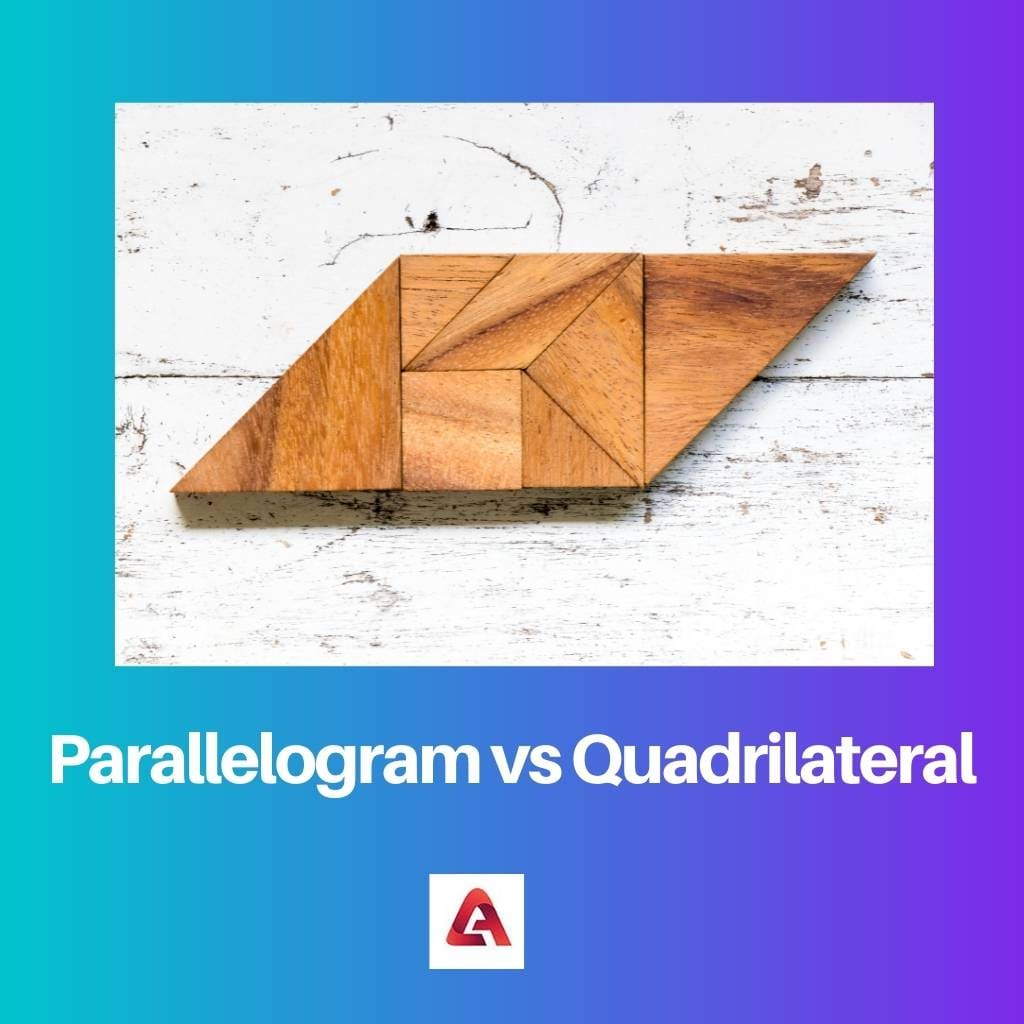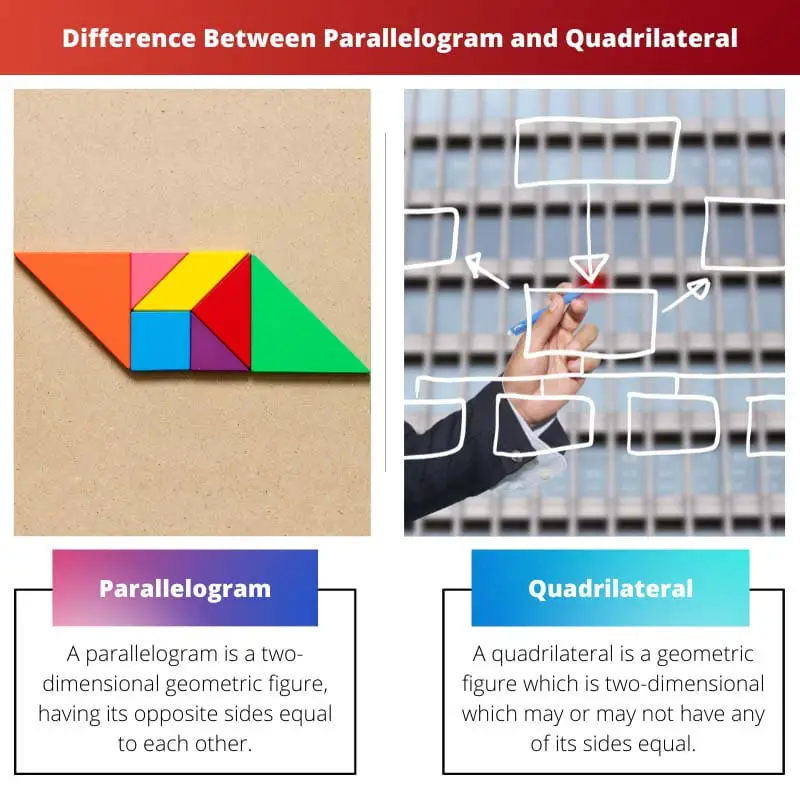A parallelogram and a quadrilateral are both four-sided. A parallelogram comes under a quadrilateral. Because a quadrilateral means a four-sided shape. A parallelogram is a type of quadrilateral.
Both quadrilaterals and a parallelogram have their properties and characteristics which set them apart. The total of all angles of a parallelogram and quadrilateral is 360 degrees.
Key Takeaways
- A parallelogram is a quadrilateral with two pairs of parallel sides, while a quadrilateral is a four-sided polygon.
- Unlike a parallelogram, not all quadrilaterals have parallel sides. A quadrilateral can have sides of different lengths and angles.
- Both parallelograms and quadrilaterals have several properties and formulas associated with their sides, angles, and diagonals, which are useful in geometry and mathematics.
Parallelogram vs Quadrilateral
The difference between a parallelogram and a quadrilateral is that a parallelogram is a four-sided shape with opposite sides having an equal length to each other. On the other hand, a quadrilateral is a four-sided shape that may or may not have opposite sides similar to each other, like a parallelogram.

A parallelogram is a two-dimensional geometric figure. This shape has four sides to it, along with four corners. Out of these four sides, the opposite sides of a parallelogram have the same length. They not only have the exact contrasting measurements, but opposite sides are parallel to each other too.
A Quadrilateral is a two-dimensional geometric figure. This shape may or may not have all sides of it equal or parallel to each other. Many kinds of conditions come under the same category. A quadrilateral has four sides to it, along with four corners. The part ‘quad’ in quadrilateral means four.
Comparison Table
| Parameters of Comparison | Parallelogram | Quadrilateral |
|---|---|---|
| Definition | A parallelogram is a two-dimensional geometric figure, having its opposite sides equal. | A quadrilateral is a two-dimensional geometric figure that may or may not have any of its sides equal. |
| Opposite sides | In a parallelogram, opposite sides are always parallel to each other. | In a quadrilateral, the opposite sides may or may not be parallel. |
| Opposite angles | In a parallelogram, the sum of the opposite angles is always equal: always 180 degrees which are supplementary angles. | The opposite angles of a quadrilateral may or may not always be equal or supplementary angles. |
| Types present | There are fewer types of parallelograms as compared to quadrilaterals. | There are more types of the quadrilateral as it is compared to parallelogram. |
| Characteristic | All parallelograms are said to be quadrilaterals. | Not all quadrilaterals cannot be said a parallelograms. |
What is Parallelogram?
A parallelogram is a two-dimensional geometric figure. This shape has four sides to it, along with four corners. Out of these four sides, the opposite sides of a parallelogram have the same length. They not only have the exact contrasting measurements, but opposite sides are parallel to each other too.
When a parallelogram is made to be divided, it can be cut into two triangles. These two triangles will be congruent to each other, and the angles formed alternating the interior angles will always be equal. The sides of the triangles corresponding to each other will also be identical.
The angles of a parallelogram are always supplementary. Supplementary angles are those angles whose measure is always 180 degrees. There are different types of parallelograms: a square, a rectangle, a rhombus, etc.
A laptop, a desk, and a blackboard are different examples of parallelograms in our daily lives.

What is Quadrilateral?
A Quadrilateral is a two-dimensional geometric figure. This shape may or may not have all sides of it equal or parallel to each other. Many kinds of conditions come under the same category. A quadrilateral has four sides to it, along with four corners. The part ‘quad’ in quadrilateral means four.
Many types of shapes come under the quadrilateral category. Eacformpe that comes under the quadrilateral has its functions and properties. The properties and characteristics of the body depend on which kind of quadrilateral they are.
For instance, a parallelogram is a quadrilateral with two sides equal, whereas a square is a quadrilateral with all four equal sides.
The objective measure of all angles of a quadrilateral is always 360 degrees. There are different types of a quadrilateral which are square, rectangle, rhombus, and even parallelogram, for that matter. A table, a desk, and a kite are different examples of quadrilateral in our daily life.

Main Differences Between Parallelogram and Quadrilateral
- A parallelogram is a two-dimensional geometric figure, having its opposite sides equal. On the other hand, a quadrilateral is a two-dimensional geometric figure that may or may not have any of its sides similar.
- In a parallelogram, the opposite sides are always parallel to each other. On the other hand, in a quadrilateral, the opposite side may or may not be similar.
- In a parallelogram, the opposite angles are always equal, always 180 degrees. On the other hand, the opposite angles of a quadrilateral may or may not always be equal.
- There are fewer types of parallelograms compared to quadrilaterals, whereas there are more quadrilaterals compared to parallelograms.
- All parallelograms are said to be quadrilaterals, but all quadrilaterals cannot be said to be parallelograms.
- The opposite side of a parallelogram is always said to be equal, whereas, in the case of a quadrilateral, the opposite sides may or may not be equal.

- https://www.tandfonline.com/doi/abs/10.1080/14794802.2014.933711
- https://www.tandfonline.com/doi/abs/10.1080/03055698.2011.643106

Not convinced that the differences between the two are significant. The article could do a better job of highlighting the practical importance of these differences.
This article provides a comprehensive and detailed comparison of parallelograms and quadrilaterals, which is beneficial for those delving into geometry.
The examples used in the article were very helpful in understanding the differences and similarities between these shapes.
Agreed, the depth of information is definitely beneficial for those studying geometry.
The article’s comparison is clear and concise. It’s a great starting point for anyone looking to understand the differences between a parallelogram and a quadrilateral.
I particularly appreciated the examples provided to help visualize the points made. Very useful article.
This article is very informative and well-organized. The clear distinction between parallelograms and quadrilaterals is presented in a logical manner.
While the article is thorough in its comparisons, the tone could be made more engaging and accessible to a wider audience.
Indeed, simplifying the language would make it more approachable for students and a general audience.
I concur, the language used could be more inclusive of learners across various levels.
The detailed comparison between parallelograms and quadrilaterals certainly enhances the reader’s understanding of these geometric concepts.
I have to agree, the depth of this article’s explanation contributes significantly to a comprehensive understanding of parallelograms and quadrilaterals.
Indeed, the thoroughness of this comparison underscores the distinctions between these two geometric shapes.
This article provides an in-depth comparison between a parallelogram and a quadrilateral. The explanation is very clear and it provides a detailed overview of their differences and defining characteristics.
I couldn’t agree more. It’s refreshing to read such a well-informed and thoroughly explained article.
This is a great article, especially for those looking to refresh their understanding of these geometric shapes.
This is a solid article, but it could benefit from a more engaging and conversational tone to captivate readers’ interests.
Absolutely, incorporating a conversational style would enhance reader engagement.
Agreed, a conversational tone would make this material more enjoyable to read and retain.
The article provides an excellent and lucid explanation of the characteristics that define parallelograms and quadrilaterals. It’s a fantastic resource for students and educators alike.
Although the article is informative, it might be beneficial to include more practical implications and real-world applications of understanding these shapes.
Agreed, a real-world application section could enhance the practical value of this article.